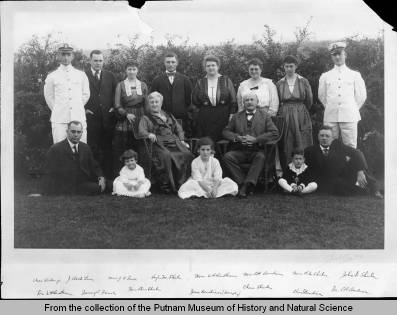
One Prospect Drive
Davenport, Iowa

History of Hillside
Hillside One Prospect Drive, Davenport “A short history”
This was the Charles Shuler residence until 1951. It was designed by Frederick G. Clausen, assisted by his son Rudolph J. Clausen. It was built in 1905. The Clausen’s were local architects of great regional significance who specialized primarily in commercial buildings and very prestigious residential structures. The architectural style is Georgian Colonial Revival with a decked hipped roof, rectangular plan with projecting semicircular bays at each corner on the east and west sides. There is a full length south veranda dominated by a two-leveled columned projecting pavilion, the upper part of which was enclosed sometime after 1921.

Mr. Shuler was born in 1856 and died in 1948 at the age of 92. This local entrepreneur chose Davenport as his home in 1896. Mr. Shuler owned Shuler Coal and had title to vast coal mines through Southern Illinois, Iowa, Missouri, Colorado and Wyoming. He also owned what is now Scottsdale, Arizona. He was primarily in the coal and lumber business, but also very important in the general construction trade. He owned and was president of the Iowa National Bank, Federal Surety Co., Standard Federal Fire Insurance Co., Vice President of Linograph Finance Corp., and Westco-Chippewa Pump Co. His obituary in the Davenport Times 28 May 1948 states: Charles Shuler, 92, coal mines operator, lumberman, banker and one of the last remaining business leaders from the group who built Davenport from a small city to an important commercial center in the years between 1900 and through the 1929 depression. . . “
The house itself sits in a pivotal location as the entrance to the Prospect Park Historic District. The structure is of solid brick with a slate roof and copper trim. The front columns are 30+ feet high and fluted with Ionic capitals. All secondary columns are 15 feet high. The porches have hand-laid mosaic tile floors (the tiles are the size of pennies) with intricate patterns. The intricately turned balusters are made of Ponderous Pine while the rest of the exterior woodwork is of Cyprus.
The inside three floors and full basement and attic have a basic square floor plan. If we eliminate the attic and basement there is approximately 8,000 square feet of living space. The windows are all very large leaded plate glass. The bay areas are complemented by large curved leaded glass windows and the outside brick work is actually curved (not flat set on a curve). All vestibules, baths and the kitchen are of hand laid mosaic tile floors with various colors and patterns. There is a guest bath on the first floor, two and a half baths on the second, a full bath on the third (servants quarters) and a gentleman’s toilet in the basement off the billiard room. The first floor has a kitchen, butlers’ pantry, food pantry, dining room and two parlors. The second floor has 5 bedrooms and two sitting rooms. The third floor has a kitchen, bedroom living/dining room and walk out deck to view the Mississippi River. All of the wood work in the entire home has been restored and is as it would have been originally.
Hillside was listed on the National Register of Historic Places February 4, 1982.